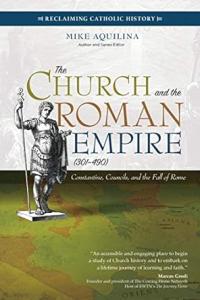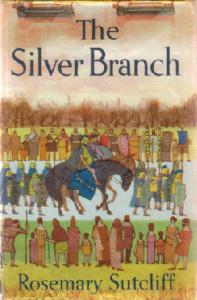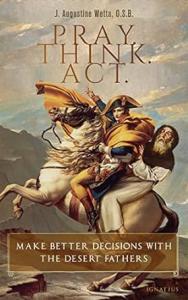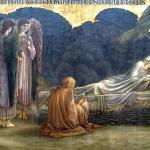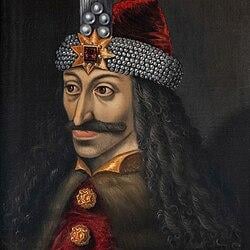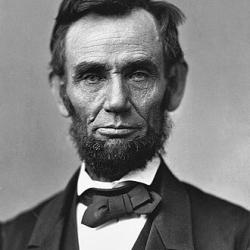Last Time on Heck of a Ride Around The Sun
The First Century Of Christianity- HOARATS
History Of The First Century Of The Catholic Church
My attempt in these next set of blog posts is to list some of the popes that reigned since Jesus gave Peter the keys of his brand new established church in the first century. And some of the other events that happen along side it.
The truth is that there have been obviously good and obviously evil Popes, controversial Popes and forgotten Popes. Formosus was so hated by his successor, the corrupt Stephen VI, that his rotting corpse was disinterred and subjected to a court trial. St. Leo the Great frightened Attila the Hun into sparing Rome, while St. Gregory the Great banished the plague from the Eternal City by holding a procession. St. Leo III crowned Charlemagne Emperor by surprise on Christmas Day, but John XII (himself the son of a Pope) was killed by his mistress’ lover, and died in her arms. The history of the Popes is the history of Christianity, still the dominant religion in Europe and the Americas. Understanding the Papacy in its historical setting is key to understanding the modern world.
-Charles A Coulombe Vicars of Christ: A History of the Popes (2014) Tumblar House
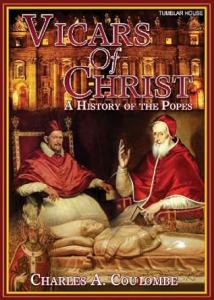
I also list the ecumenical councils that convened to define doctrine plus some of the doctors of the church that were born in that 1000 year period. And also a few other noted interesting events. This is not a detailed summary of popes and councils or other historical things. To go into great detail of all the historical Catholic and secular events including the heretics, saints, persecutors and all the saintly and unsaintly popes would take up more space then I should write in one entry and also require much more research to understand and decipher all that information. I included some book recommendations that if you the reader want to dive deeper into church history can find these books and learn more.
NOTE: Many of the Facts are quoted directly from Wikipedia
2nd Century 100 – 199
Popes 6 – 15: All Saints
1 Anti-Pope
The history of the Catholic Church is an extraordinary drama of divine and human action. At the center of that history are the saints — more influential than kings and nobles, often more so than popes and Church leaders. As Dorothy Day, twentieth-century American advocate for the poor, observed, “It is the saints that keep appearing all thru history who keep things going.” These men and women are not mere side actors in history, busy being “holy” while people in high places made Church history. The saints — those whom the Catholic Church has canonized, or recognized as especially holy — are the ones who have led the Church through her history.
-Randall Petrides, How the Saints Shaped History (2023 ) Our Sunday Visitor
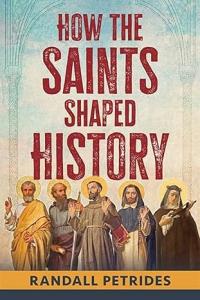
The children’s historical novel The Forgotten Daughter by Caroline Snedeker is set in 2nd century AD. It is set in ancient Rome, where a nobleman’s daughter, believed dead, is being raised as the daughter of a slave. The novel, illustrated by Dorothy P. Lathrop, was first published in 1933 and was a Newbery Honor recipient in 1934.
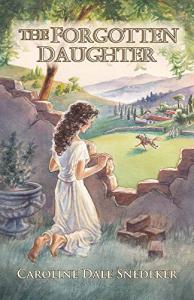
The Eagle of the Ninth (1954) by Rosemary Sutcliff is a children’s novel set in Roman Britain in the 2nd century AD, after the building of Hadrian’s Wall.
Ptolemy (c. 100 – c. 170 AD) compiles a catalogue of all stars visible to the naked eye. He also compiles three of the most influential books in western history:
-
- the Almagest which becomes the basis for western and Middle Eastern astronomy until the time of Nicolaus Copernicus and Johannes Kepler.
- the astrological treatise, Tetrabiblos.
- the Geographia.
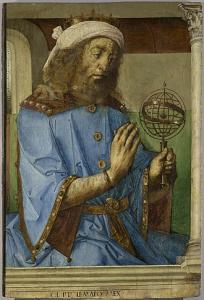
105: Cai Lun (c. 50–62 – 121 CE) of China invents paper.
142 – 154: The Antonine Wall is built across what is now central Scotland.
156 Bishop Polycarp of Smyrna (AD 69 – 155) is martyred. The sole surviving work attributed to him is the Epistle of Polycarp to the Philippians, a mosaic of references to the Greek Scriptures, which, along with an account of Martyrdom of Polycarp, forms part of the collection of writings called Apostolic Fathers. After the Acts of the Apostles, which describes the death of Stephen, the Martyrdom is considered one of the earliest genuine accounts of a Christian martyrdom.
165 The philosopher Justin, called “Martyr,” (c. AD 100 – c. AD 165) is executed in Rome. Most of his works are lost, but two apologies and a dialogue did survive. The First Apology, his most well-known text, passionately defends the morality of the Christian life, and provides various ethical and philosophical arguments to convince the Roman emperor, Antoninus, to abandon the persecution of the Church.
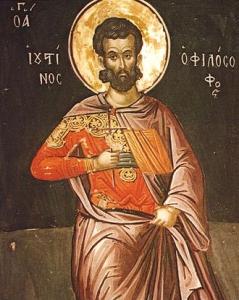
15th-century icon of Justin Martyr by Theophanes the Cretan
180 – Dr. St. Irenaeus, (c. 130 – c. 202 AD) writes Against Heresies. St. Irenaeus (Doctor of Unity) became a Doctor of the Church in 2022.
“He who was the Son of God became the Son of man, that man … might become the son of God.”
― Against Heresies
Pope # 14 St Victor I ( May 189 – July 28, 199 (10 years, 63 days)
First pope to have been born on the continent of Africa.
Hindu number system :It was developed in the Indian subcontinent between the 1st and 6th centuries CE.
Late 2nd century AD- The Metamorphoses of Apuleius, which Augustine of Hippo referred to as The Golden Ass (Asinus aureus), is the only ancient Roman novel in Latin to survive in its entirety.
The protagonist of the novel is Lucius. At the end of the novel, he is revealed to be from Madaurus, the hometown of Apuleius himself. The plot revolves around the protagonist’s curiosity (curiositas) and insatiable desire to see and practice magic. While trying to perform a spell to transform into a bird, he is accidentally transformed into an ass. This leads to a long journey, literal and metaphorical, filled with inset tales. He finally finds salvation through the intervention of the goddess Isis, whose cult he joins.
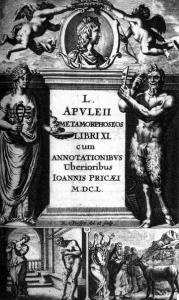
Title page from John Price‘s Latin edition of Apuleius’ novel Metamorphoses, or the Golden Ass (Gouda, Netherlands, 1650)
3rd Century 200 – 299
Popes 16 – 29: All Saints
2 Anti – Popes
“Shepherd of Tender Youth” is a Christian hymn credited to St. Clement of Alexandria. Written in 200 CE, it is one of the oldest Christian hymns to date, but historians have only uncovered the lyrics and not the music. As a result, different churches or singers have different versions of the song, depending on the tune they’ve chosen. St. Clement, who converted from paganism to Christianity, wrote the song for recent converts, using youth as a metaphor for their new roles as Christians. 13 Oldest Hymns In The World – Oldest.org
203 Perpetua and Felicitas (c. 182 – c. 203) (aged 20–21) are arrested, along with their catechism class. The Passion of Saints Perpetua and Felicity is a diary by Vibia Perpetua describing her imprisonment as a Christian in 203, and is completed after her death by a redactor. It is one of the oldest and most notable early Christian texts. and is eventually martyred in the arena in Carthage, North Africa.
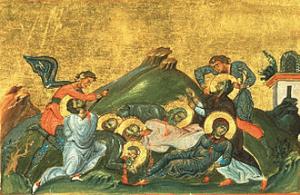
The martyrdom of Perpetua, Felicitas, Revocatus, Saturninus and Saturus
from the Menologion of Basil II (c. 1000 AD)
Early 200s Tertullian, (c. 155 – c. 220 AD) He was the first Christian author to produce an extensive corpus of Latin Christian literature. He was an early Christian apologist and a polemicist against heresy, including contemporary Christian Gnosticism. Tertullian has been called “the father of Latin Christianity“, as well as “the founder of Western theology“.
Tertullian originated new theological concepts and advanced the development of early Church doctrine. He is perhaps most famous for being the first writer in Latin known to use the term trinity (Latin: trinitas). However, some of his teachings, such as the subordination of the Son and Spirit to the Father, were later rejected by the Church. He later apostatized and joined the Montanist sect.
Pope # 18 St Pontian: (August 21, 230 – (September 28, 235) (5 years, 38 days)
First to abdicate after exile to Sardinia by Emperor Maximinus Thrax. The Liberian Catalogue records his death on September 28, 235, the earliest exact date in papal history.
260s Another wave of persecution results in the martyrdom of Pope # 23 St. Stephen of Rome, 12 March 12, 254 – 2 August 2, 257) (3 years, 143 days) Novatian, and Bishop Cyprian of Carthage, as well as St. Lawrence ( December 31 AD 225 – August 10, 258)
When Pope # 24 Sixtus (August 30, 257 – 6 August 6, 258) (341 days)became the Pope in 257, he ordained the young Lawrence who was only 32, as a deacon, and later appointed him as “archdeacon of Rome”, the first among the seven deacons who served in the cathedral church. This was a position of great trust that included the care of the treasury and riches of the Church and the distribution of alms to the indigent.
After the death of Sixtus, the prefect of Rome demanded that Lawrence turn over the riches of the Church, and St. Ambrose wrote that Lawrence asked for three days to gather the wealth. He worked swiftly to distribute as much Church property to the indigent as possible to prevent it from being seized by the prefect. On the third day, at the head of a small delegation, he presented himself to the prefect. When ordered to deliver the treasures of the Church, he presented the city’s indigent, crippled, blind, and suffering, and declared that these were the true treasures of the Church: “Here are the treasures of the church. You see, the church is truly rich, far richer than your emperor!”
The prefect was so angry that he had a great gridiron prepared with hot coals beneath it and had Lawrence placed on it, hence Lawrence’s association with the gridiron. After the martyr had suffered pain for a long time, the legend concludes, he cheerfully declared: “I’m well done on this side. Turn me over!” From this, St. Lawrence derives his patronage of cooks, chefs, and comedians.
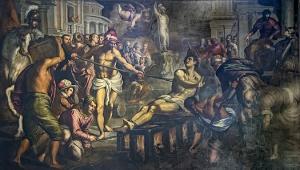
St. Valentine. The Catholic Encyclopedia and other hagiographical sources speak of three Saints Valentine that appear in connection with February 14. One was a Roman priest, another the bishop of Interamna (modern Terni, Italy) both buried along the Via Flaminia outside Rome, at different distances from the city. The third was said to be a saint who suffered on the same day with a number of companions in the Roman province of Africa, of whom nothing else is known.
Saint Sebastian ( c. AD 255 –c. AD 288) was an early Christian saint and martyr. According to traditional belief, he was killed during the Diocletianic Persecution of Christians. He was initially tied to a post or tree and shot with arrows, though this did not kill him. He was, according to tradition, rescued and healed by Irene of Rome, which became a popular subject in 17th-century painting. In all versions of the story, shortly after his recovery he went to Diocletian to warn him about his sins, and as a result was clubbed to death.
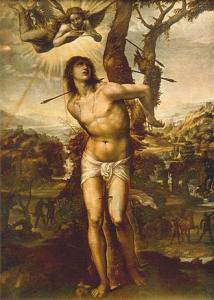
Martyrdom of Saint Sebastian, by Il Sodoma, c. 1525
From the first through third centuries, Christians had suffered intermittent bloody persecution. Their constant prayer was for “the peace of the Church.” Now, for the first time, Christians found themselves presented with what looked like the conditions for peace: the free exercise of their religion. As the Church emerged from the shadows, its scriptures took their canonical form, as did its discipline, forms of worship, and structures of governance.
Near the beginning of this era came a council, the Council of Nicaea in 325, that would ever afterward represent Christianity’s mainstream belief. These centuries were a time of outsized heroes—personalities such as St. Athanasius of Alexandria, St. Jerome, and St. Augustine. Constantine the Great, the first openly Christian emperor, stands out not only in any history of the period, but any history of the world.
These centuries were also a time of catastrophe. Barbarians penetrated the city of Rome, sacked it, and eventually claimed it as their own. Today, we measure ourselves as Christian by standards set by the Church in these centuries. We read the Bible that was published then. We keep the liturgy as it was set to paper then. We recite the Creed that first defined what Christians believe.
by
The Silver Branch is a historical adventure novel for children written by Rosemary Sutcliff and published in 1957, with illustrations by Charles Keeping. Set in Britain in the last decade of the 3rd century, it is the story of Justin and Flavius, two cousins in the Roman legions who find themselves in the intrigue and battle surrounding the struggles between Carausius, a self-proclaimed emperor in Britain, Allectus, Carausius’s treasurer, and Constantius, emperor in Rome.
Popes 30 – 39: All Saints
EXCEPT # 36 Liberius.
He is however revered as a saint in Eastern Christianity
2 Anti – Popes
301: Armenia first to adopt Christianity as state religion.
303 Diocletian (242/245 – 311/312) begins the Great Persecution which is just one of many persecutions of Christians in the first centuries of Christianity.
Fabiola or, the Church of the Catacombs is a novel by the English Cardinal Nicholas Wiseman. It was first published in 1854. The novel has been adapted to film three times. The story is set in the early 4th century AD, Rome, during the time of the persecution of Christians under the Roman Emperor Diocletian.
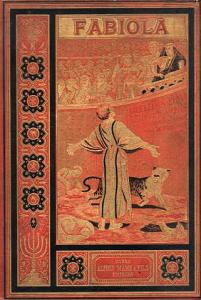
306–337: Constantine the Great, (February c. 272 – 22 May 22, 337 ) ends persecution of Christians in the Roman Empire (see also Constantinian shift) and Constantinople becomes new seat of government (New Rome).
Pope # 32 St Miltiades: First pope after the end of the persecution of Christians through the Edict of Milan (313 AD) issued by Constantine the Great. Presided over the Lateran council of 313.
Pope # 33 St Sylvester I: Pope during the First Council of Nicaea (325), the first ecumenical council. Under him was built: the Archbasilica of Saint John Lateran, Santa Croce in Gerusalemme and Old St. Peter’s Basilica.
Catholic Ecumenical Council #1
The First Council of Nicaea (325)
This council repudiated Arianism, declared that Christ is “homoousios with the Father” (of the same substance as the Father), and adopted the original Nicene Creed; addressed the Quartodeciman controversy by fixing the date of Easter; recognized authority of the sees of Rome, Alexandria and Antioch outside their own civil provinces and granted the see of Jerusalem a position of honor.
What exactly is an ecumenical council? The word “council” refers to a meeting of any group of people with responsibility to deal with issues facing the group, for example, a student council or a parish council. In the Catholic Church the term usually means a meeting of bishops, either on their own or with the pope.
As currently constituted, that is, in union with the pope, the ecumenical council is the supreme teaching authority in the Catholic Church. Its doctrinal decisions have, for Catholics, the same authority as Scripture and the traditional teachings of the episcopal magisterium, that is, the bishops’ role as teachers in the church.
The first eight councils were held before the eleventh-century schism between the Western, Latin Christians—ancestors of modern Catholics and Protestants—and the Eastern, Greek Christians—ancestors of the Orthodox churches of today. In fact, all eight councils met in Greek-speaking areas and were conducted in Greek. The next ten councils, all Western, Latin-speaking councils, occurred before the Protestant Reformation.
Joseph F Kelly, The Ecumenical Councils of the Catholic Church: A History (2009 ) Liturgical Press
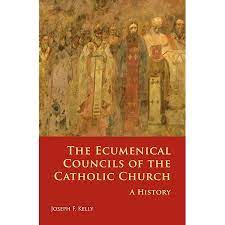
Saint Nicholas of Myra (traditionally March 15, 270 – December 6, 343) may or may not have been at the council. An early list makes him an attendee at the First Council of Nicaea in 325, but he is never mentioned in any writings by people who were at the council. Late, unsubstantiated legends claim that he was temporarily defrocked and imprisoned during the council for slapping the heretic Arius. Deacon Steven D. Greydanus concludes that, because of the story’s late attestation, it “has no historical value.
Another famous late legend tells how he resurrected three children, who had been murdered and pickled in brine by a butcher planning to sell them as pork during a famine.
In one of the earliest attested and most famous incidents from his life, he is said to have rescued three girls from being forced into prostitution by dropping a sack of gold coins through the window of their house each night for three nights so their father could pay a dowry for each of them.
His reputation evolved among the pious, as was common for early Christian saints, and his legendary habit of secret gift-giving gave rise to the traditional model of Santa Claus (“Saint Nick“) through Sinterklaas. Saint Nicholas is the patron saint of sailors, merchants, archers, repentant thieves, children, brewers, pawnbrokers, toymakers, unmarried people, and students in various cities and countries around Europe.
September 14, 335 – Emperor Constantine I consecrates the Church of the Holy Sepulchre in Jerusalem. Also known as the Church of the Resurrection, the church in the Christian Quarter of the Old City of Jerusalem. It is considered to be the holiest site for Christians in the world, as it has been the most important pilgrimage site for Christianity since the fourth century.
According to traditions it contains two sites considered holy: the site where Jesus was crucified at a place known as Calvary or Golgotha, and Jesus’s empty tomb, which is where he was buried and resurrected.
Learn More… The Tomb of Christ (Church of the Holy Sepulcher, Garden Tomb, Talpiot Tomb, Others) (sqpn.com)
On October 26, 2016 – The Church of the Holy Sepulchre is a church in the Christian Quarter of the Old City of Jerusalem. It contains, according to traditions dating back to the fourth century, the two holiest sites in Christianity: the site where Jesus was crucified, at a place known as Calvary or Golgotha, and Jesus’ empty tomb, where He is believed by Christians to have been buried and resurrected. The marble covering protecting the original limestone slab upon which Jesus was thought to have been laid by Joseph of Arimathea had been temporarily removed for restoration and cleaning as a result revealing the original slab for the first time since 1555.
337: Constantine the Great is baptized on his death bed.
Pope # 37 St Damasus I (October 1, 366 – December 11, 384) (18 years, 71 days)The first pope from modern-day Portugal. Patron of Jerome, commissioned the Vulgate translation of the Bible. Pope during the First Council of Constantinople (381), the second ecumenical council. He was also at the Council of Rome (382). He was the first pope to be the official head of the church after the Emperor Gratian abdicates the title of “Pontifex Maximus“.
Catholic Ecumenical Council #2
The First Council of Constantinople (381)
This council repudiated Arianism and Macedonianism, declared that Christ is “born of the Father before all time”, revised the Nicene Creed in regard to the Holy Spirit.
Doctors of the Church
born (or almost born) in this century.
Dr. St. Athanasius of Alexandria (c. 296–298 – 2 May 373)
Dr. St. Ephrem the Syrian c. 306 – 373)
Dr. St. Hilary of Poitiers (c. 310 – c. 367)
Dr. St. Cyril of Jerusalem (c. 313 – 386)
Dr. St. Gregory of Nazianzus (c. 329 – 25 January 25, 390)
Dr. St. Basil of Caesarea ( 330 – January 1 or 2, 379)
Dr. St. Ambrose of Milan (c. 339 – 4 April 397)
Dr. St. John Chrysostom (c. 347 – 14 September 407)
Dr. St. Jerome (c. 342–347 – September 20, 420)
Dr. St. Augustine of Hippo ( November 354 – 28 August 28, 430)
Dr. St. Cyril of Alexandria (c. 376 – 444)
Dr. St. Peter Chrysologus (c. 380 – c. 450)
Dr. St. Athanasius of Alexandria: Doctor of the Church. Wrote an biography in 360 of St. Anthony of the Desert. Anthony was one of the desert fathers.
The very first monks and nuns began to appear in the Egyptian desert around the second half of the third century A.D. They wanted to be martyrs, but they had a problem: the Roman Empire at the time was sympathetic to Christianity. In fact, Christianity was made the official religion of the whole empire in A.D. 380, so there were precious few opportunities to be flayed, burned, or eaten by lions. Instead, they opted for what they called “white martyrdom”—a form of extreme Christianity that took literally the scriptural commands to “be perfect” (Mt 5:48), to “pray constantly” (1 Thess 5:17), and to “sell what you possess and give to the poor” (Mt 19:21).
They considered themselves spiritual athletes—athletae Dei—and they competed with one another in fasting, abstinence, poverty, asceticism, and even humility. As plagues and wars and political chaos began to overwhelm the civilized world, more young men and women began to see the folly of it all, and the desert began to fill up with monks and nuns. Like Jesus, they were deeply hesitant to write anything down, but also like Jesus, they were happy to give advice when asked, because all that meditation and silence had the effect of making them master problem solvers. Visitors began to address them as Father and Mother (Abba and Amma in Aramaic). And their advice was passed down from monk to monk for hundreds of years.
Augustine J Wetta, Pray. Think. Act.: Make Better Decisions with the Desert Fathers(2023) Ignatius Press.
AD 397 and 400- Dr. St. Augustine of Hippo crafts his Confessions, an autobiography that recounts his intellectual and spiritual development. He became a Doctor (One of the four Great Latin Fathers; (Doctor of Grace) of the church in 1298.
“And men go abroad to admire the heights of mountains, the mighty waves of the sea, the broad tides of rivers, the compass of the ocean, and the circuits of the stars, yet pass over the mystery of themselves without a thought.”
“Thou hast made us for thyself, O Lord, and our heart is restless until it finds its rest in thee.”
― Confessions
August 28, 397 – Council of Carthage: The biblical canon is definitely declared.
390 CE – St. Ambrose of Milan writes the song O Splendor of God’s Glory Bright
399 – 412: The Chinese Buddhist monk Faxian sails through the Indian Ocean and travels throughout Sri Lanka and India to gather Buddhist scriptures.
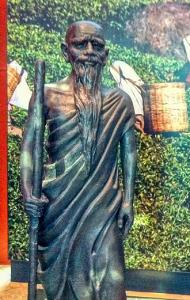
Next Time on
HOARATS
Popes And Councils Of The 5th, 6th And 7th Centuries HOARATS | Mark Wilson (patheos.com)
To Understand
What I love and How I Write About History
Hit the Link Above.
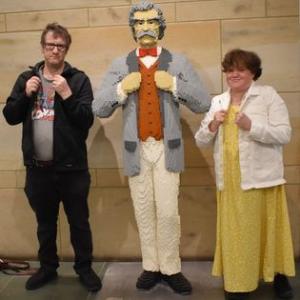
To understand about this particular series I’m writing about, please read
The Catholic Bard’s Guide To History Introduction
And to view a historical article click on


